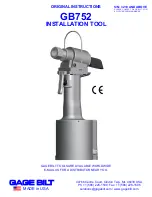
39
Need help or have any questions? Call us at 1-714-963-0329 or send us an e-mail at [email protected]
SECTION 24: FLYING THE KWIK FLY II ARF
The Kwik Fly II ARF is designed for those pilots who are comfortable flying a trainer airplane and who might also have a few
flights on a low-wing sport model. It is not a basic trainer. If you do not feel comfortable about test-flying the airplane, don't
hesitate to ask someone more experienced for help.
When set up for test-flying, the Kwik Fly II is like flying a low-wing sport-trainer. It's a nimble flyer that has a low wing
loading. This makes it predictable during slow flight and landing. Its long tail moment and generous flying surfaces result
in an airplane that is very forgiving during flight, yet will do most aerobatics you want to perform. These traits make the
Kwik Fly II a great aerobatic trainer for someone just learning aerobatics or for the seasoned pilot who wants to brush
up on his or her skills.
WARNING
To prevent any chance of control surface flutter, always reduce engine power during down-leg maneuvers.
Never fly the airplane at full throttle in a downward attitude. Doing so can over-speed the airplane and cause control
surface flutter, which can quickly lead to airframe damage and/or a crash.
TAKE-OFF
Because the Kwik Fly II has tricycle landing gear and a wide gear stance, ground handling is very solid. Thanks to the built-
in right thrust, the takeoff roll should require very little right-stick input to keep the airplane tracking straight. If you find that
the airplane is "squirrely" on the ground, we suggest reducing the amount of throw in the nose gear. The nose gear should
rotate no more than 3/8" - 1/2" in each direction.
During the takeoff roll, it's important to let the airplane get up to flying speed before lifting off the ground. Lifting the airplane
off the ground too fast will cause the airplane to stall and crash. You should allow the airplane to gain sufficient speed, then
gently pull the airplane off the ground and into a shallow climb.
IN THE AIR
In the air the Kwik Fly II is very smooth and docile and exhibits a solid "feel." With the control throws set to the "Test-Flying"
settings, the airplane will fly crisply with good control authority, but not so much as to get you into trouble. This is ideal for
those learning basic aerobatics.
Setting the control throws to the "Aerobatic Flying" settings opens up a whole new dimension to the airplane. With these
settings the airplane becomes responsive in most all attitudes, even at low rates of speed. With these settings, the
airplane will perform just about any aerobatic maneuver you can dish out.
We suggest that if you use the "Aerobatic Flying" settings, you make these your "high rates" and make the "Test-Flying"
settings your "low rates." This way, for take-off, general flying and landing you can use low rates, and for aerobatic flying
you can flip to high rates.
LANDING
The beauty about the Kwik Fly II is its wide flight envelope. This means that even though the airplane is capable of great
aerobatics, the airplane feels just as at home flying slowly. This makes for an airplane that is easy to land. And with the
included center-flap, spot landings are easily done, too.
Deploy the center-flap to increase wing lift and descent rate. Using the center-flap will also allow the airplane to land even
slower. If you deploy the center-flap at too high an airspeed, the airplane will have a tendency to balloon upwards. To
counteract this, either deploy the center-flap at a lower airspeed or, if you have a programmable radio system, mix a couple
of degrees of down elevator when the center-flap deploys.
On your initial upwind leg, reduce power and allow the airplane to begin slowing down. Follow your normal landing
procedure, allowing the airplane to gradually lose altitude and speed. When turning onto final approach the airplane
should have a slightly nose-down attitude and you should be carrying a small amount of power to control your descent.
Just before touch-down, reduce power to idle and let the airplane settle onto the main gear. At this point, use the elevator
to hold the nose gear off the ground. As the airplane rolls out and loses speed, the nose gear will drop onto the ground. As
always, when landing be careful not to over-control. Over-controlling leads to excessive oscillations which don't make for
good landings.






































